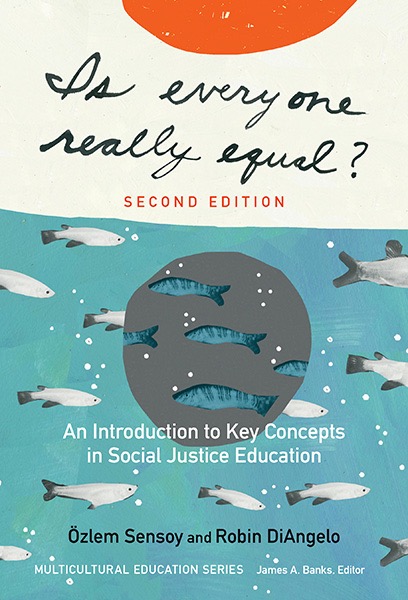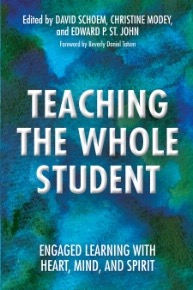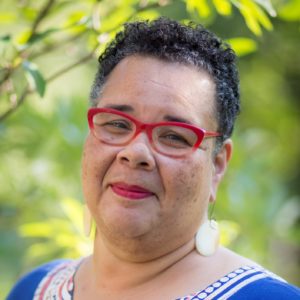social justice
Select an item by clicking its checkbox
Whether teaching online or face-to-face courses, Mary Hess, Luther Seminary, aims to create spaces where (in the words of Parker Palmer) obedience to truth can be practiced. “Learning,” she argues, “is risk-taking.” But she lets her students know that she, as the teacher, is with them in their learning adventure. Dr. Hess has had a variety of leadership roles at the Wabash Center over many years.
The “I” That Teaches - A new video project that invites senior scholars to talk about their teaching lives. These scholar-teachers candidly discuss how religious, educational, and family backgrounds inform their vocational commitments and, also, characterize their teaching persona. From the vantage point of a practiced teaching philosophy we get an intimate account of the value and art of teaching well.
Click here to watch all episodes of "The "I" That Teaches" on YouTube
See Also:
“Doc, if I teach what you are talking about I’ll get fired!” “Talking about this in seminary is fine, but if I try to talk about white supremacy on my job –won’t I get fired?” “If I talk about racism and oppression in my church-I’ll get fired.” ...

Is Everyone Really Equal? An Introduction to Key Concepts in Social Justice Education
Date Reviewed: March 23, 2018
This book is one among fifty others within the Multicultural Education Series. According to the series editor James A. Banks, these books “[summarize and analyze] important research, theory, and practice related to the education of ethnic, racial, cultural, and linguistic groups in the United States and education of mainstream students about diversity” (xiii). Özelm Sensoy and Robin DiAngelo’s book focuses on social justice. For distinction from the commonplace notion of social justice, Sensoy and DiAngelo use the alternative term “critical social justice.” By critical social justice, they mean: (1) recognition of unequal social power relations at the individual and group levels in society; (2) understanding of one’s place within these relations of unequal power; (3) critical thinking on what knowledge is and how it is produced and acquired; and (4) action informed by the best understanding of what social justice is and sound methods for its realization in society (xxi). Sensoy and DiAngelo provide guidelines for teaching and learning social justice.
The book consists of twelve chapters. The chapters include: pictures; charts; figures; vocabulary lists; boxes for definitions of key terms and reminders of ideas and concepts if discussed in a previous chapter; questions for discussion; and instructions for learning activities. The authors intend for persons to read the chapters in their numerical order. The content of the book is cumulative, with each chapter building upon the one that precedes it.
There is an underlying logic in the linear progression of the chapters. Chapters 1 and 2 deal with instructional matters, providing students with guidelines for learning social justice course content (6-18), instructors with guidelines for grading student performance (19-21), and both with an overview of critical theory in social justice courses (25-27). Chapters 3 to 5 define the concepts and operations of culture, socialization, prejudice and discrimination, and oppression and domination (36-40, 51-57, 61-73). Chapters 6 to10 define ableism, sexism, racism, and classism and describe how they pervade social institutions (82-86, 104-115, 123-129, 142-144, 156-162, 177-182). Chapter 11 refutes 13 common statements that are used to discredit social justice education (186-197). Based on Sensoy and DiAngelo’s definition of critical social justice, Chapter 12 specifies four learning outcomes for social justice education and crafts possible scenarios for illustration of the kinds of actions for each outcome (200, 203-204, 207, 211).
Though written primarily for white readers, Sensoy and DiAngelo’s book merits consideration by all readers interested in social justice education in pluralistic society. The series editor notes that “most of the nation’s teachers are white, female, and monolingual” (xii). Using the terms “we” and “us” throughout the book, Sensoy and DiAngelo acknowledge their associations with this demographic group (120). Given the fact of intersectionality – that any one person has multiple associations – race or ethnicity cannot be a person’s only identification (138, 175). The complexity of human subjectivity warrants the concern of all persons with social justice in a world characterized by ever-increasing diversity.

Teaching the Whole Student - Engaged Learning With Heart, Mind, and Spirit
Date Reviewed: December 13, 2017
This book gives both more and less than what its title promises. For the editors of this collection, teaching “the whole student” requires engaged learning (“active, participatory, experiential learning that links doing with thinking”) and integrative pedagogy (“crossing and stretching traditional intellectual disciplinary boundaries”) (1). In turn, these commitments are part and parcel of a larger commitment to educating for social justice, and the essays take on a wide array of topics, including effective and balanced service-learning, learning communities “done well,” and the importance of meaningful, sustained diversity engagement. Some of the essays are rather auto-biographical while others focus on a particular course or program. As is the case with many books of this type, the collection is an uneven assortment, and it is not always clear how an essay pertains to the promised subject of “teaching the whole student.” For those reasons, it can be somewhat disappointing.
Read in one way, however, hope emerges as a kind of connecting line and important theme. This is addressed most directly in the essay by Gillies Malnarich, who describes a moment of personal crisis as a teacher. She lay awake at night wondering, “What does it mean to educate for hope?” How can we make space for “raw, angry, heartbreaking, life-affirming hope… especially in our classrooms,” she asks, drawing upon both Paulo Freire and Rebecca Solnit’s writings (58). It also becomes clear that the kind of relational pedagogy being prescribed by many of the writers requires a willingness on the part of the teacher to bring his or her whole self into the classroom. In her essay on “Incorporating Social Justice into Teaching,” Kathleen Manning encourages readers to think of teaching as a spiritual act: “Teaching is not something learned once and perfected. The ever-changing nature of students, theory, and your personal and professional cycles as a person and professor make teaching an art. Because you are affecting people’s lives, approaching teaching and learning as spiritual practice places it in the realm of transcendence. Particularly when using principles of social justice to work toward a more just world, faith, trust, and authenticity must be part of the teaching and learning processes” (52).
There are many helpful ideas and strategies here, including the “Where I’m From” poetry assignment, a powerful way for students to disclose important aspects of their identity and express “links between their faith tradition and ethnicity,” among other things (164 - the activity comes from Beverly Daniel Tatum’s Can We Talk About Race? [Beacon, 2007]). Some of the essays include useful appendices - see, for example, the collaborative learning self-assessment (77) or the chart describing experiential classroom activities to promote dialogue (143).
Ultimately the strength of this book can be found in the questions that it poses more than in the answers it suggests. Each essay concludes with a set of reflection questions prompted by the content of the essay, and a patient, thoughtful reader could work her way through this book and be richly rewarded.

Multiculturalism on Campus: Theory, Models, and Practices for Understanding Diversity and Creating Inclusion, 2nd Edition
Date Reviewed: September 15, 2017
The Introduction to the second edition of Multiculturalism on Campus states that the book’s purpose is to provide “a comprehensive resource for students, faculty, and higher education administrators about multiculturalism and diverse populations on college campuses”(1). In addition to that goal, the second edition sets out, successfully, to give “greater voice to students who are not part of the dominant cultures” (1). The format includes clear and succinct case studies that assist in revealing the experiences of each group of these students on college campuses. Authors include discussion questions at the end of their essays to assist in processing the material and to move the conversation forward.
Arranged into three perspectival parts with substantive essays addressing “Awareness of Cultural Issues,” “Information on Cultural Populations,” and “Critical Consciousness of Cultural Competence,” the book itself is a model of diversity and inclusion insofar as each essay can be understood as a roadmap for those who are just beginning to engage with the topic of multiculturalism on college campuses or it can serve to enrich and affirm the understandings of those who have been working in the area of student development and multiculturalism.
The essays in the section on “Awareness of Cultural Issues” address foundational questions through the application of sociological, psychological, and student development theories. The discussions related to describing multiculturalism and understanding the effects of oppression on student development (Chapters 1 and 2) are filled with insights that can be related to the foundational concepts which have helped to shape curriculum in social justice and Catholic social teaching.
In Part Two, descriptions of the various cultural populations that enrich our college campuses accurately reflect the diverse picture that exists today. Chapters on gender – “Men and Women” (Ch. 12) and “Lesbian, Gay, Bisexual and Transgender Students” (Ch. 13) – as well as the “Adult Student” (Ch. 14), “Students with Disabilities” and “Religious and Spiritual Diversity among College Students” (Ch. 15 and 16) are extremely helpful in presenting a dynamic picture of the reality that is the American college campus today. The information in these chapters is supported with data and cultural insights. Studies cited in each of the essays in this second section serve as significant entry points for further research while at the same time enlightening the newcomer to the diverse cultural context that shapes the lives of today’s college students. The abundance of information contained in the essays may seem overwhelming at times. However, each essay concludes with recommendations and discussion questions that provide support for the development of action plans that focus on inclusion. The questions assist students, faculty, and administrators with engaging in constructive critical discourse that leads to effective strategizing.
Part Three addresses the ways in which the development of “Critical Consciousness of Cultural Competence” can occur. In this section, we come to understand that an intersectional framework is necessary for successful progress in developing the critical consciousness needed to engage in the work of inclusion and diversity. The work of social justice education is noted as holding the key to effecting change or progress in this area (384). The concept of an intersectional framework as presented here can be of assistance to those of us who are teaching courses in Catholic social teaching or peace and justice, as it demands the same competencies as those expected from the application of Catholic Social Teaching. The mastery of content along with the recognition of intersection of the various cultural contexts that inform the lives of students is something that needs to reverberate throughout the curriculum in higher education if we are to move forward as a society. The creation of inclusive campuses is the first step in bringing about real societal change and Multiculturalism on Campus is a valuable tool in making that happen.
